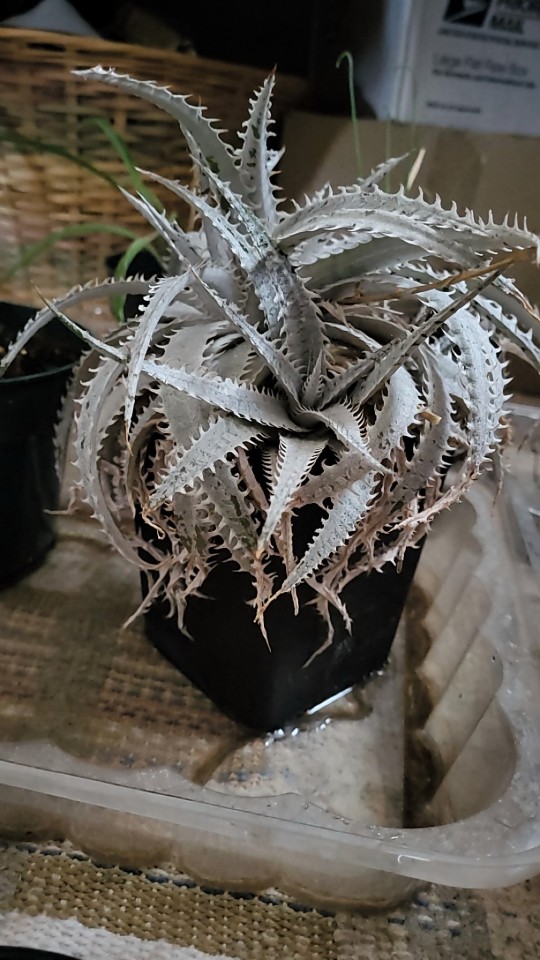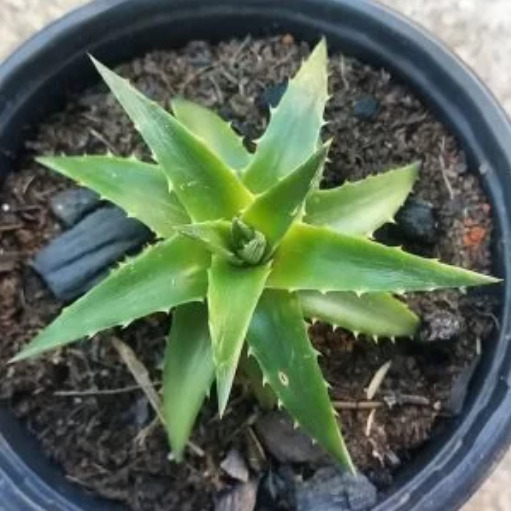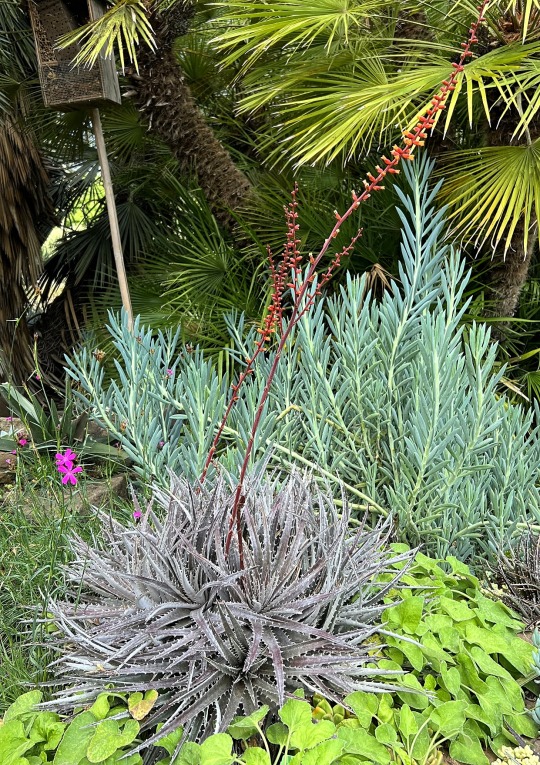#dyckia
Text


Dyckia hybrid
Here is another example of a Dyckia hybrid, this one with yellow-orange petals and sepals. Its flower stalk is quite tall - about 2 meters.
-Brian
21 notes
·
View notes
Text
instagram
5 notes
·
View notes
Text


dyckia imprints (2014)
#photography#my photography#dyckia#I really miss having a bunch of dyckia they're awesome little plants
17 notes
·
View notes
Photo

🌱 小型で白いとか最高やん🌟 . . #dyckialittlewing #bromeliad #dyckia #plantplant #tukkajakukka #tukkajakukka_plants #plantsmakepeoplehappy https://www.instagram.com/p/CqO_DfKv7Gz/?igshid=NGJjMDIxMWI=
#dyckialittlewing#bromeliad#dyckia#plantplant#tukkajakukka#tukkajakukka_plants#plantsmakepeoplehappy
2 notes
·
View notes
Text

Every time I look at this increasingly larger cluster of PAIN I mean beauty and think about how to repot it I weep and put it off longer
7 notes
·
View notes
Photo

鉢パンパンで限界なので分けた。 革手袋必須。 #ヘクチアレピドフィラ #ヘクチア #ディッキア #ブロメリア #多肉植物 #hechtialepidophylla #hechtia #dyckia #bromeliads #succulents https://www.instagram.com/p/CjK1trXLmCQ/?igshid=NGJjMDIxMWI=
0 notes
Note
hey did you know that um. hummingbirds are one of the few birds that will not eat bees AND they often hang out at flowers together. stanningbird? :-)
if the bucket is replaced to fit the gardeny theme it would probably be a dyckia. but apparently marigolds can deter bees because of their strong smell and their “pom pom” variety is very hard for bees to drink from. hummingbirds can drink just fine though, if that’s any indication of why i picked it
oh, i like it though! Stanningbird looks more logical then Beetley xdd
i don't actually think that bucket would be replaced... maybe there is just dyckia or/and marigolds in it? and i would actually be very excited to see your thoughts about TK and Mariella!
thank you :D
#the stanley parable#tsp#tsp narrator#tspud#the stanley parable narrator#stanley parable#tsp ultra deluxe#the insect parable
13 notes
·
View notes
Text
0 notes
Text
[WIP] Intro to Bromeliads: Surprising Tropicals for the Zone 9a Garden
Bromeliads are a special family of flowering plants from the Americas that have many adaptations for low-water including CAM-photosynthesis (like cacti). Some are terrestrial like your typical plant but others are able to grow on trees and rocks, scientifically known as “epiphytic” and “lithophytic” respectively. Many bromeliads are great both for beginner gardeners and snobs (me) alike.
Bromeliad categories:
Dyckia & Succulent - Dyckia, Puya, Hechtia, Encholichreron are (somewhat) common genera in circulation these are the bromeliads tend to be more terrestrial or lithophytic, growing in low rainfall areas kind of like an agave or a standard cactus
Airplant - Tillandsia species - these are often wispy plants which gather water from special hairs on their leaves rather than roots which gives them usually a silvery appearance. Airplants are found from South America into the mid-Atlantic USA in a variety of habitats with some even growing on cacti in deserts such as the fragrant and quite large Tillandsia duratti.
Tank & Urn broms aka “classic broms” - common genera are Neoregelia, Aechmea, Billbergia, and Vriesea, these are the popular idea of a brom, plants with stiff leaves that often store water in their centers (known as the “tank”) most of these are native to tropical and subtropical forests in Central and South America.
Note on Hardiness:
For all marginal plants, especially “tank” bromeliads and mounted plants, the rule of thumb is to provide oak canopy or a similar reliable, evergreen cover. This is crucial in climates like Deep South where freezes typically are short in duration, occurring briefly during cloudless nights in winter. The oak canopy functions as a blanket for the plants and keeps the cold (which comes from above!) setting in and potentially also keeping any morning dew from freezing into frost. Bromeliads cope much better with “dry cold”. London is zone 9 just like my area, I’ve visited and seen our native Cabbage palms growing big in London, but they cannot grow half the bromeliads we can. This is because the UK has a wetter and longer-lasting cold. [If you are in UK reading this: look on inat at Tillandsia species growing in Argentina and at Aechmea recurvata].
Photo caption: A collection of bromeliads underneath a native Sand live oak (Quercus geminata)
Photo caption: Billbergia nutans mounted to a Southern live oak, this patch has endured temperatures of 23F and several nights in mid-20s after that. It gets no irrigation or fertilizer.
Siting Bromeliads:
Most bromeliads grown are from humid forests where they evolved to grow on trees. Dappled shade and part sun conditions are almost always best for them for this reason. As mentioned above, the canopy cover is also important to protect the plants from extremes in weather temperature.
If growing in the Southeast, you tend to not have to worry about increasing humidity but I also find localized areas of increased humidity benefit bromeliads and other epiphytes.
Examples of increased humidity areas in my garden:
Tree over a paved surface (water evaporating off paved surface)
Near an air conditioner (these drip out water all day)
Over my small frog pond
Look for lichens and other epiphytes as evidence of suitable areas for humidity-lovers.
Bromeliads that can be grown both terrestrially and epiphytically are perfect for areas of dry shade/high root competition such as at base of native Cabbage palm or particularly thirsty trees like my Red maple.
Caption: A bed with extreme root competition at base of native Red maple (Acer rubra) and Cabbage palm (Sabal palmetto) featuring many bromeliads.
Mounting bromeliads
I recommend using aluminum wire or a natural twine for mounting bromelaids where needed. Plastics like synthetic rope and fishing lines are dangerous to wildlife and, especially synthetic fibers, degrade into microplastics and nanoplastics which are so small they can cross the blood-brain barrier (if you wouldnt bite into a credit card, you shouldnt be using that stuff basically).
Sometimes with the bromeliad shape you can get by just putting it on and using Beard airplant wrapped around it. Some also use wood glue but it is important not to cover too much of the plant if it is an airplant as the plant needs to get water through its leaves.
Bromeliads and other epiphytes including orchids tend to favor the following characteristics:
Furrowed bark (easiest to grab onto)
Evergreen canopy (protects from temperature extremes)
“Leakiness” (tree releases more minerals than average = more fertilizer for epis!)
Live oaks satisfy all three of those characteristics which is why they are draped in beard airplants in the Deep South.
Cypress are also “leaky” and favored by airplants but they do not have furrowed bark nor are they evergreen so outside of zone 10b+ they are not as good for marginal species.
If you are unable to have a full-sized Live oak, I recommend the extremely under-utilized small native oak species Quercus myrtifolia (the record largest is 39 feet but typically they are shorter than two storeys). For reference, the common as sin Japanese Waxleaf privet is a much bigger plant than this and much quicker in growth rate yet I also see it planted right next to houses. You also could try a native holly like the Dahoon or a Weeping yaupon and keep them as small trees.
As far as exotics go, Bottlebrush has furrowed bark and I can recommend it for all day sun to part sun conditions. For no more than 8 hours of sun, Pineapple guava is great but it does have flaky bark so attachment may not occur.
Good Beginner Tank Broms:
Androlopsis skinneri 'Paradise', very nice huge brom for warmer zone 9a
Aechmea caudata, e.g. 'Santa Catarina' perhaps my favorite of the established zone 9a species
Aechmea disticantha warning that it is a vicious bastard of a plant, but probably the hardiest of the larger Aechmea species to my knowledge
Aechmea recurvata
"matchstick" bromeliads e.g.
Aechmea apocalyptica
Aechmea cornata
Aechmea cylindrata
Aechmea gamosepala (probably the most common)
Aechmea x 'Burgundy' hybrid with disticantha parentage but much smaller and less vicious with good foliage color
Billbergia nutans
Other Billbergia hybrids might be hardy as well, a plant that appears to be the cultivated hybrid 'Hallelujah' bloomed through 3 days of mid-20s night temps under oak in a very sheltered location (notably firebush in same area was of course knocked to the ground).
Many Neoregelia hybrids, at work the following had little to no damage during mid-20s:
Neoregelia Cruenta
Neoregelia Super Fireball
Noid that lookes like Neoregelia Raphael
Noid that looks like Neoregelia ___
Nidularium innocentii
Androlopsis x Aechmea disticantha = O'Rourke very nice intergeneric likely hardier than Androlopsis parent thanks to disticantha but this also makes it a bit more brutal to handle than Androlopsis
Airplants for zone 9a:
Showy species native to North FL
Tillandsia bartramii
Tillandsia x floridana
Tillandsia usenoides aka "Spanish moss" (i call beard airplant)
South TX Tillandsia baileyi
"Southern Cone" airplants such as:
Tillandsia aeranthos
Tillandsia albertiana
Tillandsia stricta
Tillandsia tenuifolia
Misc. species
Tillandsia ionantha
0 notes
Text

Dyckia Brevifollia (Bare Rooted)
0 notes
Text



Dyckia hybrid
Dyckia is a genus in the Bromeliad Family, and the various species occur in southern Brasil and southward to Argentina. They usually form clumps of sharp-toothed rosettes, and their flowers are always in the yellow-to-orange range. There are many fine hybrids available in horticulture, and this is one example, with its purplish leaves dusted with silver scales, and its tall spires of orange flowers (set off by the red stalk and sepals).
-Brian
18 notes
·
View notes
Photo

Dyckia illustration & timelapse Motif : @yurupu @ssn.sunny スケッチから着彩までスピード重視で描いた。雑な感じが気に入ってる👍 Now I’m trying to color my illustration directly from sketch as quick as possible ✨ https://www.instagram.com/p/Coq3suirPwF/?igshid=NGJjMDIxMWI=
2 notes
·
View notes
Video
youtube
DYCKIA VARIETIES PART 8 | BROMELIACEAE | WORLD PLANT ID | NAMA TANAMAN | INDOOR | OUTDOOR by Nama Tanam Tanaman
0 notes
Photo

🌱 ディッキア・ビックボーイ . . 今年直射で作ってたら葉が詰まって来た♪ もっと真っ赤になって欲しいからこの冬は直射の当たる軒下で管理してみようか...🤔 去年も−2~3℃は経験してるし大丈夫やろきっと.. . ま、そんな事より土曜日の準備をしないと😂 . . 11/26(土)10:00~15:30 #京都みどりのマルシェ番外編 @midorino_marche です お時間あれば是非どうぞ♪ . 勝手に犬連れ歓迎してます🐶 ウチの子も1人連れて行く予定🐖... . . #dyckiabigboy #bromeliad #dyckia #plantplant #tukkajakukka #tukkajakukka_plants #plantsmakepeoplehappy (トート阪急洛西口) https://www.instagram.com/p/ClViUIPrs1z/?igshid=NGJjMDIxMWI=
#京都みどりのマルシェ番外編#dyckiabigboy#bromeliad#dyckia#plantplant#tukkajakukka#tukkajakukka_plants#plantsmakepeoplehappy
0 notes
Photo

久々に #ディッキア たち。 #ディッキアビルベイカー #ディッキアブリットルスター #ディッキアピンクジャイアント そしてどんどん大きくなってる #プヤセルーレア 実生苗 #dyckia #puya #bromeliads #succulents https://www.instagram.com/p/Cil5NuNr-vE/?igshid=NGJjMDIxMWI=
0 notes